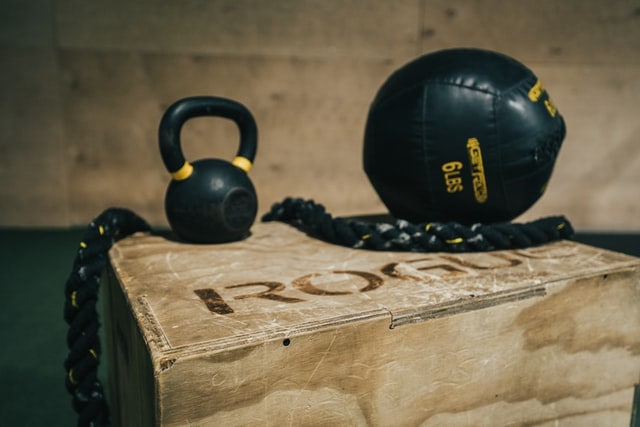Feeling bored with the same old workout routine? Feeling like it isn’t challenging you any longer? Why not try stepping up your workout with box jumps? The benefits of box jumps are numerous and easy to access if you work out regularly. All you need is a solid box and a good pair of shoes and you’re ready for a challenging and fun workout.

What are box jumps?
Box jumps are a form of jumping which is classified as a plyometric exercise. A plyometric exercise is a high-intensity exercise that:
- Increases both your speed and power, allowing you to run fast and jump high
- Prevents injuries by boosting the strength of muscles, tendons and ligaments
- Allows quicker recovery from injuries
Box jumps have grown so popular in the last few years that they are now considered the favourite form of plyometrics. This is partly due to the numerous benefits of box jumps but also because they’re so easy to add to your routine.
For box jumping, you can choose boxes of many shapes and sizes. Hollow frames, flat surfaces, made of metal or wood, cushioned or not cushioned – all variants are good options for your box jumping routine.
Get your box jump technique right
Technique and form are the bedrock on which any exercise is performed. Here are some tips to do it right and reap the benefits of box jumps:
- Stand a couple of feet away from the box, facing it, with your feet shoulder-width apart.
- Bend your knees, squat a little and jump with both feet to land on top of the box.
- Bend your knees when you land into a quarter squat.
- Step off the box carefully.
- Repeat again.
If you’re starting off, it is important to understand what are box jumps and how to do them right. Aim for a high jump that will take your feet over the box. Don’t aim only to land on the box – jump higher and imagine that the box is only there to cushion your jump on the way down. But don’t try to jump higher and higher each time – you may end up falling or injuring yourself. Perform your moves with the right form and posture. You’ll see more of the benefits of box jumps with a consistent practice than a changing one.
How to get the most out of your box jump routine
It is important to understand what are box jumps and how they fit into your regime. It is not recommended to do box jumps for your whole session. Mix it up with other activities to get a full workout and enjoy the benefits of box jumps.

To ensure that you stick to your new habit of box jumping, blend it with your general workout regimen in the following ways:
- Don’t do a box jump on cold muscles. The explosive strength required for box jumps means that your muscles will need warming up.
- Follow box jumps with your strength training session of the workout. This ensures you remain energetic and able to perform at peak levels.
- You could also do box jumps between sets or after a series of squats.
- Begin by adding box jumps to your workout twice a week and take your rest days in between so that your body can recover from the strain.
Get the benefits of box jumps for all your workout goals
Whatever your goals from your workout, you can use box jumps to help you get there. Take some time to understand what are box jumps and how they work on your body. The benefits of box jumps are great for multiple goals and they can be done in different ways to meet those goals.
Here are two approaches – one based on power and one on conditioning – to help you get to where you want to:
- If you’re working on power and explosive strength of the muscles, do 3-4 sets of box jumps with 5 reps in each set. Make sure you get enough rest in between so that you can perform them with the right form.
- If you’re focused on endurance, start off with a smaller box and aim for 3 sets of 20 reps each. Do not stop for more than a minute between each set.
Regardless of what your goals are, start off with a smaller box for box jumping. This allows your body to get used to the exercise before you can consider leveling up. If you are 5.5 feet or shorter, you should use a box that is no higher than 15 inches. If you are taller than 5.5 feet, you can use a higher box.

Incorporate these jumps into your general workout as a form of cardio between sets of weight training or do them in place of another cardio exercise. Depending on the benefits of box jumps you want to avail, tweak your approach and get jumping.
What are box jumps variations that I can try?
One way to change up your routine is to add weights. This ramps up the intensity and gives you a new challenge to work towards. Before you do that, consider what are box jumps and how will they fit into your routine. You will do well to stick to the original form for a few weeks before trying variations.
When you’re ready, here is how to add weights to your jumps:
- Add ankle weights or vest weights for a new challenge that will not alter the form of your jumps.
- Hold dumbbells in each hand while jumping but make sure you grip them well and avoid hitting yourself.
- If you know your form is right, you can try adding a kettlebell to your box jump routine. Lift it up with both hands to chest level and then jump.

If you want to add variations in terms of technique and not power, you can try out the following regressions and progressions:
- One of the easiest variations to a normal box is a step-up. This is a good exercise to test if this is too challenging or if you’re a beginner. With time, you can add weight and increase your speed before leveling up to an actual box jump.
- You can add to the difficulty quotient by starting the jump with two feet and landing with a single foot on the box. Alternate each foot with each repetition.
- Start from a seated position to really challenge your workout. Place the box near a bench, sit on it and then leap onto the box from a seated position.
The benefits of box jumps on muscles
All plyometric exercises are intense because they strain your muscles and push them to perform better and become stronger. After a few weeks of regular workouts, you’ll start seeing the benefits of box jumps on your muscle power, speed and strength. It is a high-intensity exercise that works on these muscles:
- Hamstrings
- Quadriceps
- Calves
- Glutes
The benefits of box jumps on training and performance
In terms of training and performance you are likely to experience the following benefits of box jumps in the long run:
- Higher endurance levels
- Improved cardiovascular health
- Weight management (an hour of any plyometric exercise can burn about 800-1000 calories)
- Stronger leg muscles
- Improved stability and mobility
- Better balance and coordination thanks to a stronger core
- Boosted muscle strength and speed
- Improved ability to jump higher
- Greater flexibility and agility
- Higher awareness of the body
- Improved energy levels and performance output
These are the benefits of box jumps that you’ll notice when you start working out, but almost any plyometric exercise offers the same benefits. If you can’t do these moves, look for something else that you can do to gain the same effects.
Staying safe while you do your box jump routine
Once you understand what are box jumps you will need to know how to do them safely. This is an intensive and highly physical move that can go wrong if you are not careful.
Before you begin jumping and availing the benefits of box jumps, make sure you do the following:
- Don’t do these moves if you are recovering from any form of injury
- If you have problems with coordination and balance, you should avoid this
- Choose a box that is sturdy and not prone to slipping
- The size of the box is important but may change depending on your experience level and current physical condition. It is recommended that you do box jumps on a box that is at knee level, but you might want to start off with smaller boxes to figure out which size works best for you. This is an excellent way to build confidence for your box jumping technique.
- If you don’t have a box, you can do these moves on staircases or benches.
- Do not rush into heavy exercises like this. Make sure you have warmed up sufficiently before any form of plyometric exercise or you may bring on a pulled muscle or a strained ankle.
- Perform your moves with focus and intent, making sure your form is correct. Leverage the low squat and the momentum of your arms as you make the jump. When you land, ensure that you land with both feet and keep a slight bend at the knees to cushion the landing.
- If you have pain in your lower back, ankles, or knees, or if you’re expecting a child, avoid such forms of plyometric exercises because they require high-intensity explosive movements

Common mistakes to avoid
Box jumps are only effective and beneficial if done right. Many people make mistakes with their routine that causes injury or doesn’t show the results they expect. Here are the mistakes you should avoid if you want to see the benefits of box jumps:
- Do not choose a box that is too high. If you start off with a box that is not right for you, it could result in you not landing on the surface or landing in a deep squat, which is not the right form. You could increase your chances of injury if you do this.
- Do not jump off the box. It is easier to control a jump up and onto the box rather than a backward or downward jump. You do not want to sprain an ankle or land in a painful position.
- The correct way to land is with your whole foot, in a quarter squat position that allows a slight bend in the knees.
In conclusion
Box jumps can be an effective way to boost your workout and build muscular strength and power. They are quite different from typical weight training regimes and cardio workouts because of the level of intensity at which they are performed. But it is important you understand what are box jumps and how intense they can be, so that you can prepare for them.
Don’t try these jumps if you’re ill, not in your usual form, or injured in any way. If you have plantar fasciitis or any form of joint pain, you should avoid doing box jumps. A jump exerts considerable pressure on joints and muscles so it is recommended to build up to them.
As with all plyometric exercises, do not do these jumps every day. The National Strength and Conditioning Association suggests not more than two to three times a week for all forms of plyometric training and exercises.
Warm up before and stretch adequately after your workout to ensure your best form and speedy recovery. Do your box jumps before weight training or other forms of cardio so that your muscles are not exhausted and can put in maximum effort. Aim for a rest period that is five times the amount of time it takes you to make it through one particular set. If you’re not sure about the right form, it is best to talk to a personal trainer to get the tips you need.
Box jumps are suitable for experienced athletes wanting to add a little extra challenge to their workout regimen. They are not advised for those who are new to exercising or recovering from injuries because of the strenuous nature of the workouts. If you are a complete beginner or are not used to plyometric exercises, try a workout at home to start off with.



